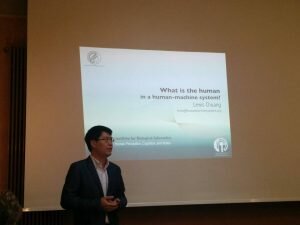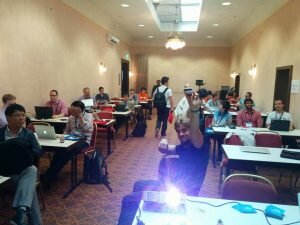RECALL researchers Tilman Dingler and Evangelos Niforatos recently collaborated with Kai Kunze (Osaka Prefecture University), Cathal Gurin (Dublin City University), Ioannis Giannopoulos (ETH Zurich), Andreas Dengel (German Research Center for Artificial Intelligence) and Koichi Kise (Osaka Prefecture University) to organize the 3rd Workshop on Ubiquitous Technologies for Augmenting the Human Mind – WAHM 2016. The workshop took place on September 12th in Heidelberg, Germany as part of the 2016 ACM International Joint Conference on Pervasive and Ubiquitous Computing (UbiComp ‘16).
WAHM 2016 brought together a team of interdisciplinary researchers and practitioners from computer science, cognitive psychology and neuroscience to discuss about the augmentation of human cognition (i.e., attention, engagement, memory, learning etc.) with the use of ubiquitous technologies. WAHM 2016 was attended by 25 participants (Figure 2) who submitted a total of 10 position papers, of which we accepted 8, involving human memory augmentation, lifelogging, cognition aware systems and eye tracking.
We were particularly excited to host Dr. Lewis Chuang from Max Planck Institute of Biological Cybernetics, Tübingen, Germany as our workshop keynote speaker (Figure 1). Lewis spoke about attention limitation and task engagement, both of which are considered critical aspects in designing cognition aware systems. Dr. Chuang’s background as a psychologist offered a valuable perspective on augmenting cognitional and human mind and showcased how they use in-lab technologies such as EEG, ECG and eye-tracking for understanding how humans seek out and process information.

RECALL had a strong presence in this year’s WAHM with a total of 3 position papers. Particularly, Tilman Dingler from USTUTT presented his vision on how mobile personal assistants (e.g., Siri on iOS) could take into account user’s current cognition levels and propose or adjust tasks accordingly. Next, Passant Algroudy, also from USTUTT presented their ongoing study on the effect of regular reviewing of lifelogging pictures on the formation and retrieval of autobiographic memories (see Figure 3). Finally, Evangelos Niforatos from USI, presented their position paper on their ongoing RECALL system deployment for supporting memory retrieval during meetings in the workplace. Presentations were in their vast majority thought-provoking and raised fruitful discussions which we resumed after lunch.


Figure 3. Passant Algroudy presenting their position paper at WAHM 2016, Heidelberg, Germany.
We continued our discussions by employing round-robin brainstorming techniques on topics that emerged from presentations and participants’ interests. The following topics emerged:
- Education and learning.
- How to motivate students through tech? (lifelong learning)
- Gamification in learning
- Student profiling and what motivates individuals in learning more
- How to support/improve student motivation
- Harvesting Lifelogs.
- Lifeloging legacy
- External memory filter: searchable/browsable lifelogs
- Projects to pursue
- Types of data to keep/delete
- Privacy by design as default option (potentially future compromises of data storages)
- Public archives of people’s lifelogs
- Studies
- Procrastination detection
- Biophysical data and boredom detection
- Long-term projects
- Internal state detection
- Student “actuation”
- Developing methodologies
- Standardized / verified test framework for memory assessments (questionnaires)
- Finding opportune moments for Experience Sampling
- Technologies into the wild / Implementation/ Application
- User diversity is a challenge
- How to increase participant diversity? (> hostel recruitment?)
- Sensing in the wild is hard
- Steps for bringing lab studies into the wild
- Wearable eye-tracking
- Model the wild through AR/VR
- Parallel approaches
Finally, we discussed potential venues to continue WAHM as a conference track, seminar or even a symposium. We are currently evaluating the various ideas we came up with — stay tuned for WAHM 2017!